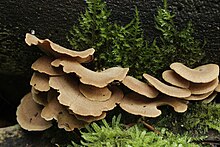 Global Information
Global InformationPanellus stipticus information
| Panellus stipticus | |
|---|---|

| |
| Scientific classification | |
| Domain: | Eukaryota |
| Kingdom: | Fungi |
| Division: | Basidiomycota |
| Class: | Agaricomycetes |
| Order: | Agaricales |
| Family: | Mycenaceae |
| Genus: | Panellus |
| Species: | P. stipticus
|
| Binomial name | |
| Panellus stipticus (Bull.) P.Karst. (1879)
| |
| Synonyms | |
| |
| Panellus stipticus Mycological characteristics | |
|---|---|
| Gills on hymenium | |
| Cap is convex or offset | |
| Hymenium is free | |
| Stipe is bare | |
| Spore print is white | |
| Ecology is saprotrophic | |
| Edibility is inedible | |
Panellus stipticus, commonly known as the bitter oyster, the astringent panus, the luminescent panellus, or the stiptic fungus, is a species of fungus. It belongs in the family Mycenaceae, and the type species of the genus Panellus. A common and widely distributed species, it is found in Asia, Australia, Europe, and North America, where it grows in groups or dense overlapping clusters on the logs, stumps, and trunks of deciduous trees, especially beech, oak, and birch. During the development of the fruit bodies, the mushrooms start out as tiny white knobs, which, over a period of one to three months, develop into fan- or kidney-shaped caps that measure up to 3 cm (1.2 in) broad. The caps are orange-yellow to brownish, and attached to the decaying wood by short stubby stalks that are connected off-center or on the side of the caps. The fungus was given its current scientific name in 1879, but has been known by many names since French mycologist Jean Bulliard first described it as Agaricus stypticus in 1783. Molecular phylogenetic analysis revealed P. stipticus to have a close genetic relationship with members of the genus Mycena.
Panellus stipticus is one of several dozen species of fungi that are bioluminescent. Strains from eastern North America are typically bioluminescent, but those from the Pacific coast regions of North America and from other continents are not. The luminescence is localized to the edges of the gills and the junction of the gills with the stem and cap. Bioluminescence is also observable with mycelia grown in laboratory culture, and the growth conditions for optimal light production have been studied in detail. Several chemicals have been isolated and characterized that are believed to be responsible for light production. Genetic analysis has shown that luminescence is controlled by a single dominant allele. The luminescent glow of this and other fungi inspired the term foxfire, coined by early settlers in eastern and southern North America. Modern research has probed the potential of P. stipticus as a tool in bioremediation, because of its ability to detoxify various environmental pollutants.